Making Room for Our Forthcoming Rivers
Abstract
:1. Introduction
2. Evolving Paradigms Guiding River Setting
- ecosystem health;
- flood risk (and damages);
- management costs.
2.1. Classic Engineering Paradigm
- -
- keep river channels hydraulically efficient so as to let the flood flow as quick as possible → dredging, recalibration, de-vegetation, rectification;
- -
- keep the water within the channel, avoiding overflows → levees, by-pass;
- -
- keep the river (and the terrain slopes) in place, avoiding any movement → bank defenses (rip rap, dikes, groynes), weirs, torrent control works, etc.
- Damages occur because rivers are not “clean”: there is need to dredge sediments and eliminate riparian vegetation (notice that this misuse of the term “clean” is a reality in newspapers and in the general language of non-technical policy makers);
- There is not enough money for the defense works that would save us: there is need for political pressure.
- Schemes based on defense works are likely to often respond not as designed (e.g., multi-purpose reservoirs will not be empty at the critical moment because the event may occur in an unexpected period; a retention tank will be filled by a relatively small pre-flood and then ineffective for the successive large one; an overflow canal may be obstructed by a small local landslide, or the modeling exercise carried out in the prediction was imprecise or even incorrect);
- Events exceeding the design threshold are always possible (even without invoking climate change);
- The river is not only water, there is a geomorphological dynamic that can significantly change its behavior in time because of processes such as incision, aggradation, meandering, avulsion, etc.;
- A system controlled by artificial structures is (extremely) fragile: such structures may fail (even for events lower than the design one) and the higher their presence, the more likely the failure (see Figure 2, left);
2.2. Total Risk Paradigm
2.3. The Cost-Benefit Analysis Paradigm
- δ = 1/(1 + r): discount factor with the social interest rate r;
- T: planning time horizon (years).
3. The Overflowing Quest of Climate Change for a More Daring Approach
3.1. Climate Change: Just a Matter of Modifying Return Periods TR?
- Global Circulation Models (GCMs) provide today very different answers in terms of average precipitation (p) and temperature (t) (Figure 6); even more significant is the difference in terms of climate variability [43] which, eventually, is the key feature driving flood risk and is predicted to increase by more than average figures (e.g., [44]);
- A changing climate may not only increase the magnitude of an event for a given TR, but even modify the climatic mechanisms responsible for the formation of floods. In such a way, a large basin may see events never registered before, where possibly several significant tributaries may experience a flood simultaneously. An example was experienced in 2006 by the Danube when an extremely rare coincidence of relatively large floods occurred in the subbasins of the Upper Danube at the same time as flooding on the Tisza, Sava and Velika Morava, and led to a very serious 100-year flood event along more than 1000 km of the river [45];
- Scientists are making big efforts to predict climate by GCMs, downscaling, fascinating, complex machine learning techniques and others (e.g., [46]). However, possibly the largest unknown factor is how nations will indeed behave in terms of carbon emissions reduction (or increase); or—very sad to say—what will be the effect of the current war in Ukraine: more emissions because of a reboosted use of coal, or less because of an accelerated development of alternative energy sources? Last, but not least, is the uncontrollable contribution by terrestrial, and particularly subaerial volcanos, or permafrost melting, amongst others.
3.2. Time Horizon
3.3. A More Daring Paradigm in a Systems View
- Accept that safety does not exist, we need to live and cope with risk trying to minimize it, balancing costs, and adapting to futures now predictable only with very high uncertainty and no sound probability knowledge;
- Reduce risk by acting on all its components: exposed value, vulnerability and hazard. However, avoid as far as possible “grey” solutions because they imply an eternal, increasing economic burden on future generations (OMR costs), create a fake safety perception, while they increase real residual risk because they may (and do) fail. We rather need to reduce fragility, by limiting defenses to more modest works (that in case of collapse generate smaller, bearable damages), and more “green” infrastructures, i.e., Nature Based Solutions;
- Understand, respect and re-establish geomorphological dynamics (sediment transport and balance, space to wander, meander or avulse, longitudinal and lateral continuity) including the status, processes and role of riparian vegetation and woody debris;
- Design modular interventions with a flexible approach in order not to regret unnecessary costs borne now, nor to contradict present actions in the next future;
- Reduce residual risk (RR) by equipping and preparing the territory, particularly outside the protected area, including urban zones. To this end:
- -
- reduce exposure (resettlement);
- -
- reduce vulnerability (real time alert systems, adaptation by water proofing and moving towards hydro-cities);
- -
- increase resilience (organization, insurance, etc.…).
4. CBA as a Support Tool to Design River Corridors
5. Dealing with Uncertainty
- -
- Climate: this stems from the GCM modeling uncertainty (including incomplete knowledge of processes and insufficient or imprecise data to feed them) and the socio-political uncertainty about future climate altering emissions together with the natural unknown concerning volcanic or deep-sea emissions (which probably involve even greater figures). Therefore, it has both an epistemic component (linked to lack of knowledge) and an aleatory one (linked to physical processes and to political moves). Sea water levels can be seen as an element within this component. According again to Refsgaard, this can be considered as a scenario uncertainty if we restrict our world to the GCMs available; in any case, no probabilities are known. Hence, an ensemble modeling technique could be used for the GCMs’ intrinsic variability; however, given the very uncertain emissions issue, a scenarios exploration technique seems more suitable;
- -
- Hydro-climatic variables: given a hypothetical future climate, there still is a large aleatory uncertainty about the values assumed by climatic and hydrological variables at each time step of any year because of natural aleatory processes. According again to Refsgaard, this level of uncertainty can be assumed to be statistical, i.e., probabilities can be assigned, assuming that within a given climate, processes are ergodic. This component includes precipitation (p), temperature (t), wind speed etc.; yet, flowrates Q are not included as they depend on the context and also on the existing river setting and the additional interventions foreseen by any ALT of flood management plan to be included. The hydro-climatic uncertainty can be dealt with by a classic statistical approach; details are provided below;
- -
- Context represents a set of different factors potentially influencing the behavior of the system. With no claim of generality, I consider here a basic factor only, which is the possibility of collapse of works in a set of pre-defined sites of occurrence (e.g., historical failure sites, something assumed for instance in [17]), conditioned to the flowrate level Q in those river sections, with probabilities that can be estimated from historical events. According to Refsgaard, its level of uncertainty would hence be again statistical and a statistical approach can be suited for this case. Several other factors may be relevant, and can be considered, such as the functionality of defense works (e.g., a deviation canal may be occluded; mobile gates may be blocked or with no electric energy) or the downstream water level which acts as boundary condition when just a portion of a river basin is modeled (if the whole basin is considered down to the sea, its sea water level can be assumed to be associated with the climate scenario and hence known) and the degree of sediment filling of flood control reservoirs as well as their initial storage. Less technical issues may be relevant too, such as the forthcoming development of land use and associated infrastructures (new roads, new urban areas, etc.), or the prices of inputs required by the considered ALT (as discussed in particular in [27]). Concerning reservoirs and retention tanks, their water storage at the moment of a particular flood event is a consequence of the behavior and management of the system during the considered hydrological realization. As such, the water storage is, in principle, a known magnitude (given the initial storage at the beginning of the realization r) and not an alea; this is not true, however, if the simulation-management model that is adopted excludes (for the sake of simplicity) the reservoirs’ management issue. Figure 12 also indicates in synthesis a possible way out to deal with such uncertainty components.
5.1. An Operational Scheme to Deal with Uncertainty
5.2. Hints to Overcome the Computational Burden
- NxnR hydrological simulations, at daily time step along a Y-years long time series;
- N x nR x nC x nf hydraulic 1D-2D simulations, where nf is the average number of significant flood events in each realization.
5.3. Further Simplifications
5.4. Decision Criteria under Strict Uncertainty
- min regret: try not to regret other choices, i.e., choose the ALT that would generate the minimum regret for not having chosen another solution, under the set of scenarios considered (e.g., [81]).
5.5. Flexibility Revisited
6. The Quality of Life, Multi Objective Paradigm
6.1. Incorporating the Multiobjective Scheme within a Participatory Decision Making Process
- (i)
- the Technical level, i.e., the multi-objective evaluation which allows to see with clarity what is the level expected to be reached by each ALT, so discarding those clearly inefficient or unacceptable for some reason; the quantification of objectives is intended to overcome the weaknesses already identified by many (e.g., p. 390 [96]) concerning the rare definition in explicit terms of collateral purposes of flood control planning, such as improving spatial quality;
- (ii)
- the Quality of Life level, where the satisfaction of each interest group feeling affected is evaluated (possibly including the risk components disregarded so far), interest conflicts are addressed and where negotiation actually takes place leading to new ALTs, ideally through a creative, constructive, iterative process;
- (iii)
- the Strategic level, where the general welfare of society is considered by the illuminated, non-corrupted Decision Makers that we all wish for. This latter would take into account a global judgment on a) the quality of life and b) another on the intra- and inter-generational fairness of the decision. The former would collate the satisfaction expressed by stakeholders, together with a consideration of the rest of society through the output of an extended CBA exercise which reflects the efficiency in the allocation of resources (indicating, theoretically, a good satisfaction of needs and no waste; e.g., [87]); furthermore, it would include a judgment on the actual feasibility of the ALT, as well as on the ability to maintain it (financial sustainability), for, without them, no QoL can be reached and/or sustained. The intra- and inter-generational fairness would consider an appropriate distribution of pros and cons amongst social groups and the conservation of environmental assets for future generations [89]. It would therefore explicitly deal with one of the advocated weaknesses regarding equity issues, as raised [27] in front of the US Army Corps Principles and Guidelines of 1983 [26].
6.2. Governance: An Indispensable Pillar
7. Conclusions
7.1. Weaknesses of Current Practice of Flood Management Planning
7.2. Contribution of This Paper
- the present setting of rivers and their basins is unsatisfactory in large part because of the classic engineering approach to hydro-morphological risk management and its widespread socio-cultural acceptance;
- in the future climate change will make this situation harsher;
- a significant improvement is achieved by addressing explicitly the residual risk, both hydraulic and morphological;
- this awareness, together with the consideration of the importance of economic aspects and the strict link between residual risk and Operation, Management and Replacement costs (OMR), leads to an improved strategy to define river setting based on a number of principles (Section 3.3) as well as on recognizing that uncertainty towards the future is enormous and we are basically ignorant about future probabilities;
- an evolved approach to river management stems from this strategy, supported by Cost Benefit Analysis and a suitable modeling framework able to consider changes in the hydro-meteorological behavior of river basins and to determine risk (including residual risk) in an integrated, straightforward manner;
- meaningful, efficient ALTernatives (and flexible strategies) of river setting and fluvial corridor are so generated that can feed a thorough participatory decision process supported by a three-level evaluation scheme;
- the evolution of society (and its values, perceptions, etc.), and the ever-updating knowledge of the actual climate, call for an adaptive scheme that can lead us to better rivers and improved Quality of Life (QoL);
- all this must be institutionalized and supported by the two pillars of governance and participation, within a democratic framework, of course.
7.3. Improving Decision Makers Agenda
- ○
- assume a much longer planning horizon than is currently envisaged, something of the order of a century or more in order to decide actions now, while looking at the far future, while ensuring sufficient flexibility to adapt decisions afterwards;
- ○
- overcome historical time series and switch to climatic predictions, defining consistently a set of the most credible climate scenarios (including sea level rise), and their evolution, specific to each river basin;
- ○
- develop a powerful dissemination-education campaign and establish permanent communication channels, while building or reinforcing the governance capability of society;
- ○
- establish trans-disciplinary working groups: land use planning, water resources management, risk control, nature conservation, environmental assessment;
- ○
- set up verified, operational methods/tools to address the required technical steps: transforming precipitation into flowrates; simulating the hydraulics within the river and the territory, including the possible collapse of works; predict geomorphic change of rivers; assess exposed value and vulnerability for different risk components; build comprehensive evaluation indices (one for each fundamental objective), ensuring internal consistency;
- ○
- identify, through the working groups, strengths and weaknesses of the territory and of the river system (by analyzing the historical behavior and current status) and start delineating very different Alternatives of river corridor in syntony with the diverging points of view and aspirations of stakeholders; these Alternatives should incorporate explicitly new economic-financial-administrative mechanisms to foster changes (insurance, PES, taxation, social agreements, etc.) amongst measures;
- ○
- in this process, adopt the basic cost-benefit analysis not just to prioritize options, but as a design tool of Alternatives;
- ○
- undertake an open, pragmatic and honest participatory process where the different objectives are quantified first, and the pros and cons assessed afterwards, and in which candidate Alternatives are progressively modified and improved until a decision is to be made;
- ○
- document the whole process in a synthetic form, easy to be periodically updated and easy to be consulted (different to what is currently produced, where kilometers of papers have to be read each time and information is dispersed).
Funding
Institutional Review Board Statement
Informed Consent Statement
Conflicts of Interest
References
- Van Vliet, M.T.; Franssen, W.H.; Yearsley, J.R.; Ludwig, F.; Haddeland, I.; Lettenmaier, D.P.; Kabat, P. Global river discharge and water temperature under climate change. Glob. Environ. Chang. 2013, 23, 450–464. [Google Scholar] [CrossRef]
- Moran-Tejida, E.; Lorenzo-Lacruz, J.; Lopez-Moreno, J.L.; Rahman, K.; Beniston, M. Streamflow timing of mountain rivers in Spain: Recent changes and future projections. J. Hydrol. 2014, 517, 1114–1127. [Google Scholar] [CrossRef] [Green Version]
- Fadia Maghsood, F.; Moradi, H.; Reza Massah Bavani, A.; Panahi, M.; Berndtsson, R.; Hashemi, H. Climate Change Impact on Flood Frequency and Source Area in Northern Iran under CMIP5 Scenarios. Water 2019, 11, 273. [Google Scholar] [CrossRef] [Green Version]
- Capon, S.J.; Chambers, L.E.; Mac Nally, R.; Naiman, R.J.; Davies, P.; Marshall, N.; Pittock, J.; Reid, M.; Capon, T.; Douglas, M.; et al. Riparian ecosystems in the 21st century: Hotspots for climate change adaptation? Ecosystems 2013, 16, 359–381. [Google Scholar] [CrossRef]
- Mosner, E.; Weber, A.; Carambia, M.; Nilson, E.; Schmitz, U.; Zelle, B.; Donath, T.; Horchler, P. Climate change and floodplain vegetation—future prospects for riparian habitat availability along the Rhine River. Ecol. Eng. 2015, 82, 493–511. [Google Scholar] [CrossRef]
- Papadaki, C.; Soulis, K.; Munoz-Mas, R.; Martinez-Capel, F.; Zogaris, S.; Ntoanidis, L. Potential impacts of climate change on Flow regime and fish habitat in mountain rivers of the south-western Balkans. Sci. Total Environ. 2016, 540, 418–428. [Google Scholar] [CrossRef] [Green Version]
- Munoz-Mas, R.; ALopez-Nicolas, A.; Martinez-Capel, F.; Pulido-Velazquez, M. Shifts in the suitable hábitat available for Brown trout (Salmo trutta L.) under short-term climate change scenarios. Sci. Total Environ. 2016, 544, 686–700. [Google Scholar] [CrossRef]
- Gurnell, A.; Bertoldi, W.; Corenblit, D. Changing river channels: The roles of hydrological processes, plants and pioneer fluvial landforms in humid temperate, mixed load, gravel bed rivers. Earth-Sci. Rev. 2012, 111, 129–141. [Google Scholar] [CrossRef]
- Bertoldi, W.; Siviglia, A.; Tettamanti, S.; Toffolon, M.; Vetsch, D.; Francalanci, S. Modelling vegetation controls on fluvial morphological trajectories. Geophys. Res. Lett. 2014, 41, 7167–7175. [Google Scholar] [CrossRef]
- Van Oorshot, M.; Kleinhans, M.; Geerling, G.W.; Middelkoop, H. Distinct patterns of interaction between vegetation and morphodynamics. Earth Surf. Processes Landf. 2016, 41, 791–808. [Google Scholar] [CrossRef]
- Martínez Fernández, V.; van Oorshot, M.; de Smit, J.; Gonzalez del Tanago, M.; Dirk Buijse, A. Modelling feedbacks between geomorphological and riparian vegetation responses under climate change in a mediterranean context. Earth Surf. Processes Landf. 2018, 43, 1825–1835. [Google Scholar] [CrossRef]
- Parker, D.J. (Ed.) Floods; Taylor & Francis, Routledge: London, UK, 2000; Volume 1. [Google Scholar]
- Luo, P.; He, B.; Takara, K.; Xiong, Y.E.; Nover, D.; Duan, W.; Fukushi, K. Historical assessment of Chinese and Japanese flood management policies and implications for managing future floods. Environ. Sci. Policy 2015, 48, 265–277. [Google Scholar] [CrossRef] [Green Version]
- Nones, M.; Gerstgraser, C.; Wharton, G. Consideration of hydromorphology and sediment in the implementation of the EU water framework and floods directives: A comparative analysis of selected EU member states. Water Environ. J. 2017, 31, 324–329. [Google Scholar] [CrossRef]
- Fekete, A.; Sandholz, S. Here Comes the Flood, but Not Failure? Lessons to Learn after the Heavy Rain and Pluvial Floods in Germany 2021. Water 2021, 13, 3016. [Google Scholar] [CrossRef]
- Wagner, S.; Souvignet, M.; Walz, Y.; Balogun, K.; Komi, K.; Kreft, S.; Rhyner, J. When does risk become residual? A systematic review of research on flood risk management in West Africa. Reg. Environ. Chang. 2021, 21, 1–18. [Google Scholar] [CrossRef] [PubMed]
- Bomers, A. Predicting outflow hydrographs of potential dike breaches in a bifurcating river system using NARX neural networks. Hydrology 2021, 8, 87. [Google Scholar] [CrossRef]
- Klemeš, V. Dilettantism in Hydrology: Transition or Destiny? Water Resour. Res. 1986, 22, 177S–188S. [Google Scholar] [CrossRef]
- EU. Towards an EU Research and Innovation Policy Agenda for Final Report of the Horizon 2020. Expert Group on ‘Nature-Based Solutions and Re-Naturing Cities’. European Commission, Directorate-General for Research and Innovation, Directorate I—Climate Action and Resource Efficiency, Unit I.3—Sustainable Management of Natural Resources. 2015. Available online: https://op.europa.eu/it/publication-detail/-/publication/fb117980-d5aa-46df-8edc-af367cddc202 (accessed on 14 March 2022).
- Bignami, D.F.; Rosso, R. Flood Proofing Urban Areas, 1st ed.; Springer: Berlin/Heidelberg, Germany, 2019; ISBN 13 978-3030059330. [Google Scholar]
- EU. Nature-Based Solutions for Flood Mitigation and Coastal Resilience. Analysis of EU-Funded Projects; European Commission, Directorate-General for Research and Innovation, Directorate C—Healthy Planet, Unit C3—Climate and Planetary Boundaries; Publications Office of the European Union: Luxembourg, 2020; ISBN 978-92-76-18197-2. Available online: https://climate-adapt.eea.europa.eu/metadata/publications/nature-based-solutions-for-flood-mitigation-and-coastal-resilience-analysis-of-eu-funded-projects (accessed on 14 March 2022).
- Lonnquest, J.C.; Toussaint, B.; Manous, J.; Ertsen, M. Two Centuries of Experience in Water Resources Management: A Dutch-U.S. Retrospective; Institute for Water Resources, US Army Corps of Engineers, Rijkswaterstaat, Ministry of Infrastructure and the Environment: Alexandra, VA, USA, 2014.
- CIS Flood Working Group. Flood Risk Management, Economics and Decision Making Support. A Floods Working Group (CIS) Resource Document, Based on the Preparatory Scoping Paper (EU DG ENV Project 10775, Carried out by ARCADIS), and Input from the WG-F Thematic Workshop “Floods and Economics: Appraising, Prioritising and Financing Flood Risk Management Measures and Instruments” and Others. 2012. Available online: https://ec.europa.eu/environment/water/flood_risk/pdf/WGF_Resource_doc.pdf (accessed on 14 March 2022).
- Dasgupta, A.K.; Pearce, D.W. Cost Benefit Analysis: Theory and Practice; Mc Millan: London, UK, 1978. [Google Scholar]
- Sassone, P.G.; Schaffer, W.A. Cost-Benefit Analysis—A Handbook; Academic Press: San Diego, CA, USA, 1978; Number 74611; p. 190. Available online: https://www.ojp.gov/ncjrs/virtual-library/abstracts/cost-benefit-analysis-handbook (accessed on 14 March 2022).
- U.S. Water Resources Council. Economic and Environmental Principles and Guidelines for Water and Related Land Resources Implementation Studies; U.S. Water Resources Council: Washington, DC, USA, 1983.
- US Army Corps. Principles and Guidelines for Evaluating Federal Water Projects. U.S. Army Corps of Engineers Planning and the Use of Benefit Cost Analysis. A Report for the Congressional Research Service; Final Report; US Army Corps: Washington, DC, USA, 2009.
- Pinter, N.; Huthoff, F.; Dierauer, J.; Remo, J.W.F.; Damptz, A. Modeling residual flood risk behind levees, Upper Mississippi River, USA. Environ. Sci. Policy 2016, 58, 131–140. [Google Scholar] [CrossRef]
- Tariq, M.A.U.R.; Muttil, N.; Rajabi, Z.; Hussein, M.; Shah, M.I.; Shahid, M.L.U.R.; Janjua, S.; Farooq, R.; Ng, A.W.M. Development of a Hydrodynamic-Based Flood-Risk Management Tool for Assessing Redistribution of Expected Annual Damages in a Floodplain. Water 2021, 13, 3562. [Google Scholar] [CrossRef]
- Dixon, J.A.; Hufschmidt, M.M. Economic Valuation Techniques for the Environment. A Case Study Workbook; The Johns Hopkins University Press: Baltimore, MD, USA, 1986. [Google Scholar]
- MEA. Ecosystems and Human Well-Being: Synthesis; Island Press: Washington, DC, USA, 2005. [Google Scholar]
- Schaafsma, M.; Brouwer, R. Overview of Existing Guidelines and Manuals for the Economic Valuation of Environmental and Resource Costs and Benefits. Report of the EU Funded Project AQUAMONEY. 2006. Available online: http://www.aquamoney.ecologic-events.de/sites/download/aquamoney-overview-guidelines.pdf (accessed on 18 November 2010).
- Brouwer, R.; Bliem, M.; Flachner, Z.; Getzner, M.; Kerekes, S.; Milton, S.; Palarie, T.; Szerenyi, Z.; Vadineanu, A.; Wagtendonk, A. Ecosystem Service Valuation from Floodplain Restoration in the Danube River Basin: An International Choice Experiment Application. AQUAMONEY. 2009. Available online: https://vu.nl/en/about-vu/research-institutes/ivm (accessed on 18 November 2010).
- TEEB. The Economics of Ecosystems and Biodiversity: Mainstreaming the Economics of Nature: A Synthesis of the Approach, Conclusions and Recommendations of TEEB; UN Environment: Geneva, Switzerland, 2010; ISBN 978-3-9813410-3-4. [Google Scholar]
- Bateman, I.J.; Mace, G.M.; Fezzi, C.; Atkinson, G.; Turner, R.K. Economic Analysis for Ecosystem Services Assessment. Environ. Resour. Econ. 2011, 48, 117–218. [Google Scholar] [CrossRef] [Green Version]
- Environment Agency. Flood and Coastal Erosion Risk Management Appraisal Guidance FCERM-AG. Internet. 2010. Available online: http://publications.environmentagency.gov.uk/pdf/GEHO0310BSDB-e-e.pdf (accessed on 27 October 2021).
- Green, C.; Viavattene, C.; Thompson, P. Guidance for Assessing Flood Losses. CONHAZ Report WP06, Flood Hazard Research Centre, Middlesex UK. Internet. 2011. Available online: https://www.mcm-online.co.uk/wp-content/uploads/2015/04/CONHAZ_Flood_Losses_Final_Report.pdf (accessed on 15 February 2022).
- Penning-Rowsell, E.; Floyd, P.; Ramsbottom, D.; Surendran, S. Estimating injury and loss of life in floods: A deterministic framework. Nat. Hazards 2005, 36, 43–64. [Google Scholar] [CrossRef] [Green Version]
- Penning-Rowsell, E.; Johnson, C.; Tunstall, S.; Tapsell, S.; Morris, J.; Chatterton, J.; Green, C. The Benefits of Flood and Coastal Risk Management: A Manual of Assessment Techniques (The Multi-Coloured Manual); Flood Hazard Research Centre, Middlesex University, Middlesex University Press: London, UK, 2005. [Google Scholar]
- EC. Insurance of Weather and Climate Related Disaster Risk: Inventory and Analysis of Mechanisms to Support Damage Prevention in the EU; Final Report; European Commission: Brussels, Belgium, 2017; p. 109.
- IPCC. Summary for Policymakers. In Climate Change 2021: The Physical Science Basis. Contribution of Working Group I to the Sixth Assessment Report of the Intergovernmental Panel on Climate Change; Masson-Delmotte, V., Zhai, P., Pirani, A., Connors, S.L., Péan, C., Berger, S., Caud, N., Chen, Y., Goldfarb, L., Gomis, M.I., et al., Eds.; Cambridge University Press: Cambridge, UK, 2022; Available online: https://www.ipcc.ch/report/ar6/wg1/downloads/report/IPCC_AR6_WGI_SPM_final.pdf (accessed on 14 March 2022).
- IPCC. Climate Change 2021: The Physical Science Basis. Contribution of Working Group I to the Sixth Assessment Report of the Intergovernmental Panel on Climate Change; Masson-Delmotte, V., Zhai, P., Pirani, A., Connors, S.L., Péan, C., Berger, S., Caud, N., Chen, Y., Goldfarb, L., Gomis, M.I., et al., Eds.; Cambridge University Press: Cambridge, UK, 2022; Available online: https://www.ipcc.ch/report/ar6/wg1/ (accessed on 14 March 2022).
- Van der Wiel, K.; Bintanja, R. Contribution of climatic changes in mean and variability to monthly temperature and precipitation extremes. Commun. Earth Environ. 2021, 2, 1. [Google Scholar] [CrossRef]
- Bathiany, S.; Dakos, V.; Sheffer, M.; Lenton, T.M. Climate models predict increasing temperature variability in poor countries. Sci. Adv. 2018, 4, eaar5809. [Google Scholar] [CrossRef] [PubMed] [Green Version]
- ICPDR. Flood Risk Management Plan for the Danube River Basin District; International Commission for the Protection of the Danube River (ICPDR): Vienna, Austria, 2015; Available online: www.icpdr.org (accessed on 15 February 2022).
- Valikhan Anaraki, M.; Farzin, S.; Mousavi, S.F.; Karami, H. Uncertainty Analysis of Climate Change Impacts on Flood Frequency by Using Hybrid Machine Learning Methods. Water Resour. Manag. 2021, 35, 199–223. [Google Scholar] [CrossRef]
- Luger, C.; Jeuken, A.; Verbist, K.; Pande, S.; Warren, A.; Vivanco, C.; Maureira, H.; Alvarez, P. From risk assessment to adaptation pathways: Improvement of Climate Risk Informed Decision Analysis for the Limari basin in Chile. In Proceedings of the EGU General Assembly 2020, Online, 4–8 May 2020. EGU2020-8203. [Google Scholar] [CrossRef] [Green Version]
- Pendergrass, A.G.; Knutti, R.; Lehner, F.; Deser, C.; Sanderson, B.M. Precipitation variability increases in a warmer climate. Sci. Rep. 2017, 7, 17966. Available online: https://www.nature.com/articles/s41598-017-17966-y (accessed on 14 February 2022). [CrossRef] [Green Version]
- Castelletti, A.; Giuliani, M.; Amaranto, A. Scenari di Cambiamento Climatico Nell’area Urbana e Periurbana Milanese; Internal Report; Department of Electronics, Information and Bioengineering, Politecnico di Milano: Milano, Italy, 2019. (In Italian) [Google Scholar]
- Tariq, M.A.U.R.; Farooq, R.; van de Giesen, N. A Critical Review of Flood Risk Management and the Selection of Suitable Measures. Appl. Sci. 2020, 10, 8752. [Google Scholar] [CrossRef]
- Milly, P.C.D.; Betancourt, J.; Falkenmark, M.; Hirsch, R.M.; Kundzewicz, Z.W.; Lettenmaier, D.P.; Stouffer, R.J. Climate Change. Stationarity is Dead: Whither Water Management? Science 2008, 319, 573–574. [Google Scholar] [CrossRef]
- Linstone, H.A. Questioning the Methodology; Introduction; Part l; Linstone, H.A., Simmonds, W.H.C., Eds.; Addison-Wesley: Reading, MA, USA, 1977; pp. 133–143. [Google Scholar]
- Klemeš, V. Risk Analysis: The unbearable cleverness of bluffing. In Proceedings of the Third IHP/IAHS George Kovacs Colloquium on Risk, Reliability, Uncertainty and Robustness of Water Resources Systems, UNESCO, Paris, France, 19–21 September 1996. [Google Scholar]
- Refsgaard, J.C.; van der Sluijs, J.P.; Højberg, A.L.; Vanrolleghem, P.A. Uncertainty in the environmental modelling process–a framework and guidance. Environ. Model. Softw. 2007, 22, 1543–1556. [Google Scholar] [CrossRef] [Green Version]
- French, S. Decision Theory: An Introduction to the Mathematics of Rationality; Ellis Horwood: Chichester, UK, 1998. [Google Scholar]
- O’Riordan, T.; Jordan, A. The Precautionary Principle in Contemporary Environmental Politics. Environ. Values 1995, 4, 191–212. [Google Scholar] [CrossRef]
- Mendoza, G.F.; Jeuken, A.; Matthews, J.; Stakhiv, E.; Kucharski, J.; Gilroy, K. Climate Risk Informed Decision Analysis; UNESCO: Paris, France; ICIWaRM: Alexandria, VA, USA, 2018; p. 162. ISBN 978-92-3-100287-8. [Google Scholar]
- UNESCO. United Nations World Water Development Report 2020: Water and Climate Change; UNESCO: Paris, France, 2020. [Google Scholar]
- Verbist, K.M.J.; Maureira-Cortés, H.; Rojas, P.; Vicuña, S. A stress test for climate change impacts on water security: A CRIDA case study. Clim. Risk Manag. 2020, 28, 100222. [Google Scholar] [CrossRef]
- Brierley, G.J.; Fryirs, K.A. Geomorphology and River Management. Applications of the River Styles Framework; Blackwell Publishing: Carlton, Australia, 2005. [Google Scholar]
- UN/ECE. Sustainable Flood Prevention. The Hague, The Netherlands, 23–25 March 2000. Available online: https://unece.org/environment-policy/publications/guidelines-sustainable-flood-prevention (accessed on 28 October 2021).
- Water Directors of the European Union. Best Practices on Flood Prevention, Protection and Mitigation. 2003. Available online: https://ec.europa.eu/environment/water/flood_risk/pdf/flooding_bestpractice.pdf (accessed on 28 October 2021).
- EC. White Paper on Adapting to Climate Change: Towards a European Framework for Action. 147 Final Internet. 2009. Available online: http://eurlex.europa.eu/LexUriServ/LexUriServ.do?uri=COM:2009:0147:FIN:EN:PDF (accessed on 27 October 2021).
- EC. A Guide to Support the Selection, Design and Implementation of Natural Water Retention Measures in Europe—Capturing the Multiple Benefits of Nature-Based Solutions, by the Working Group of the Common Implementation Strategy “Natural Water Retention Measures”; Technical Report-2014-082; European Commission: Brussels, Belgium, 2014; Available online: http://nwrm.eu (accessed on 27 October 2021).
- Goldman, R.L.; Benitez, S.; Calvache, A.; Ramos, A. Water Funds: Protecting Watersheds for Nature and People; The Nature Conservancy: Arlington, VA, USA, 2010. [Google Scholar]
- Gómez-Baggethun, E.; de Groot, R.; Lomas, P.L.; Montes, C. The history of ecosystem services in economic theory and practice: From early notions to markets and payment schemes. Ecol. Econ. 2010, 69, 1209–1218. [Google Scholar] [CrossRef]
- Nardini, A.; Pavan, S. River restoration: Not only for the sake of nature, but also for saving money while addressing flood risk. A decision making framework applied to the Chiese River (Po basin-Italy). J. Flood Risk Manag. 2012, 5, 111–133. [Google Scholar] [CrossRef]
- Greene, A.M.; Ines, A.V.M.; Goddard, L.; Gonzalez, P.L.M.; Chryssanthacopoulos, J. A climate generator for agricultural planning in southeastern South America. Agric. For. Meteorol. 2015, 203, 217–228. [Google Scholar] [CrossRef] [Green Version]
- Hegnauer, M.; Beersma, J.J.; van den Boogaard, H.F.P.; Buishand, T.A.; Passchier, R.H. Generator of Rainfall and Discharge Extremes (GRADE) for the Rhine and Meuse Basins; Final Report of GRADE 2.0. Technical Report; Deltares: Delft, The Netherlands, 2014; ISBN 9789036914062. [Google Scholar]
- Paprotnya, D.; Kreibicha, H.; Morales-Nápoles, O.; Castellarin, A.; Carisi, F.; Schrötera, K. Exposure and vulnerability estimation for modelling flood losses to commercial assets in Europe. Sci. Total Environ. 2020, 737, 140011. [Google Scholar] [CrossRef] [PubMed]
- Wobus, C.; Zheng, P.; Stein, J.; Lay, C.; Mahoney, H.; Lorie, M. Projecting changes in expected annual damages from riverine flooding in the United States. Earth’s Future 2019, 7, 516–527. [Google Scholar] [CrossRef]
- Box, G.E.P. Science and Statistics. J. Am. Stat. Assoc. 1976, 71, 791–799. [Google Scholar] [CrossRef]
- Mascarenhas, F.C.B.; Miguez, M.G. Urban flood control through a mathematical flow cell model. Water Int. 2002, 27, 208–218. [Google Scholar] [CrossRef]
- Mascarenhas, F.C.B.; Toda, K.; Miguez, M.G.; Inoue, K. Flood Risk Simulation; Wessex Institute (WIT): Southampton, UK, 2005. [Google Scholar]
- Miguez, M.G.; Peres Battemarco, B.; Martins De Sousa, M. Urban flood simulation using MODCEL—An alternative Quasi2D Conceptual model. Water 2017, 9, 445. [Google Scholar] [CrossRef] [Green Version]
- Nardini, A.; Pavan, S. What river morphology after restoration? The methodology VALURI. J. River Basin Manag. 2012, 10, 29–47. [Google Scholar] [CrossRef]
- Hall, J.; Solomatine, D. A framework for uncertainty analysis in flood risk management decisions. Int. J. River Basin Manag. 2008, 6, 85–98. [Google Scholar] [CrossRef] [Green Version]
- Walley, P. Statistical Reasoning with Imprecise Probabilities; Chapman and Hall: London, UK, 1991. [Google Scholar]
- Ben-Haim, Y. Information-Gap Decision Theory: Decisions Under Severe Uncertainty; Academic Press: San Diego, CA, USA, 2006. [Google Scholar]
- Simon, H. Rational Choice and the Structure of the Environment. Psychol. Rev. 1956, 63, 81–97. [Google Scholar] [CrossRef] [Green Version]
- Roy, B. Aide Multicritère à la Décision: Méthodes et Case; London School of Economics and Political Science: London, UK, 1993; p. 695. [Google Scholar]
- McKay, M.D.; Beckman, R.J.; Conover, W.J. A Comparison of Three Methods for Selecting Values of Input Variables in the Analysis of Output from a Computer Code. Technometrics Am. Stat. Assoc. 1979, 21, 239–245. [Google Scholar] [CrossRef]
- Iman, R.L.; Davenport, J.M.; Zeigler, D.K. Latin Hypercube Sampling (Program User’s Guide); Sandia Labs.: Albuquerque, NM, USA, 1980. [Google Scholar]
- Amram, M.; Kulatilaka, N. Real Options: Managing Strategic Investment in an Uncertain World; Harvard Business School Press: Boston, MA, USA, 1999; 246p. [Google Scholar]
- Bertsekas, D.P. Dynamic Programming and Stochastic Control; Academic Press: San Diego, CA, USA, 1976. [Google Scholar]
- Turner, R.K. Cost-benefit analysis—A critique. Omega 1979, 7, 411–419. [Google Scholar] [CrossRef]
- Johansson, P.O. The Economic Theory and Measurement of Environmental Benefits; Cambridge University Press: Cambridge, UK, 1987. [Google Scholar]
- Jacobs, M. The Limits of Neoclassicism: Towards an Institutional Environmental Economics. Centre for the Study of Environmental Change; Mimeo: New York, NY, USA; University of Lancaster: Lancaster, UK, 1992. [Google Scholar]
- Munasinghe, M. Environmental Economics and Sustainable Development; World Bank Environmental Paper n.3; World Bank Publications: Washington, DC, USA, 1993. [Google Scholar]
- Ventegodt, S.; Merrick, J.; Jørgen Andersen, N. Quality of Life Theory III. Maslow Revisited. Sci. World J. 2003, 3, 1050–1057. [Google Scholar] [CrossRef] [PubMed]
- Nardini, A.G.C.; Conte, G. River Management & Restoration: What River Do We Wish for. Water 2021, 13, 1336. [Google Scholar] [CrossRef]
- Goicoechea, A.; Hansen, D.R.; Duckstein, L. Multiobjective Decision Analysis with Engineering and Business Applications; John Wiley: Hoboken, NJ, USA, 1982. [Google Scholar]
- Janssen, R. Multiobjective Decision Support for Environmental Management; Kluwer Academic Publishers: Amsterdam, The Netherlands, 1992. [Google Scholar]
- Busscher, T.; van den Brink, M.; Verweij, S. Strategies for integrating water management and spatial planning: Organising for spatial quality in the Dutch “Room for the River” program. J. Flood Risk Manag. 2019, 12, e12448. [Google Scholar] [CrossRef] [Green Version]
- Van der Voorn, T.; Svenfelt, Å.; Björnberg, K.E.; Fauré, E.; Milestad, R. Envisioning carbon-free land use futures for Sweden: A scenario study on conflicts and synergies between environmental policy goals. Reg. Environ. Chang. 2020, 20, 35. [Google Scholar] [CrossRef] [Green Version]
- Moulaert, F.; Van Dyck, B.; Khan, A.Z. Building a meta-framework to ‘address’ spatial quality. Int. Plan. Stud. 2013, 18, 389–409. [Google Scholar] [CrossRef] [Green Version]
- Pahl-Wostl, C.; Jeffrey, P.; Isendahl, N.; Brugnach, M. Maturing the New Water Management Paradigm: Progressing from Aspiration to Practice. Water Resour. Manag. 2011, 25, 837–856. [Google Scholar] [CrossRef]
- Van der Voorn, T.; Quist, J. Analysing the Role of Visions, Agency, and Niches in Historical Transitions in Watershed Management in the Lower Mississippi River. Water 2018, 10, 1845. [Google Scholar] [CrossRef] [Green Version]
- Buijs, J.-M.; Boelens, L.; Bormann, H.; Restemeyer, B.; Terpstra, T.; Van Der Voorn, T. Adaptive planning for flood resilient areas: Dealing with complexity in decision-making about multilayered flood risk management. In Proceedings of the 16th Meeting: Adaptive Planning for Spatial Transformation, Groningen, The Netherlands, 23–25 May 2018; p. 23. Available online: https://www.projectenportfolio.nl/images/archive/e/ea/20180906092418%2120180430_Paper_Aesop_FRAMES.pdf (accessed on 15 February 2021).
- Hegger, D.L.T.; Driessen, P.P.J.; Dieperink, C.; Wiering, M.; Raadgever, G.T.; Van Rijswick, H.F.M.W. Assessing stability and dynamics in flood risk governance. An empirically illustrated research approach. Water Resour. Manag. 2014, 28, 4127–4142. [Google Scholar] [CrossRef]
- Dieperink, C.; Hegger, D.L.T.; Bakker, M.H.N.; Kundzewicz, Z.W.; Green, C.; Driessen, P.P.J. Recurrent governance challenges in the implementation and alignment of flood risk management strategies: A review. Water Resour. Manag. 2016, 30, 4467–4481. [Google Scholar] [CrossRef] [Green Version]
- European Court of Auditors. Special Report Floods Directive: Progress in Assessing Risks, While Planning and Implementation Need to Improve (Pursuant to Article 287(4), Second Subparagraph, TFEU), n.25/2018, EU. 2018. Available online: https://www.eca.europa.eu/Lists/ECADocuments/SR18_25/SR_FLOODS_EN.pdf (accessed on 9 April 2022).
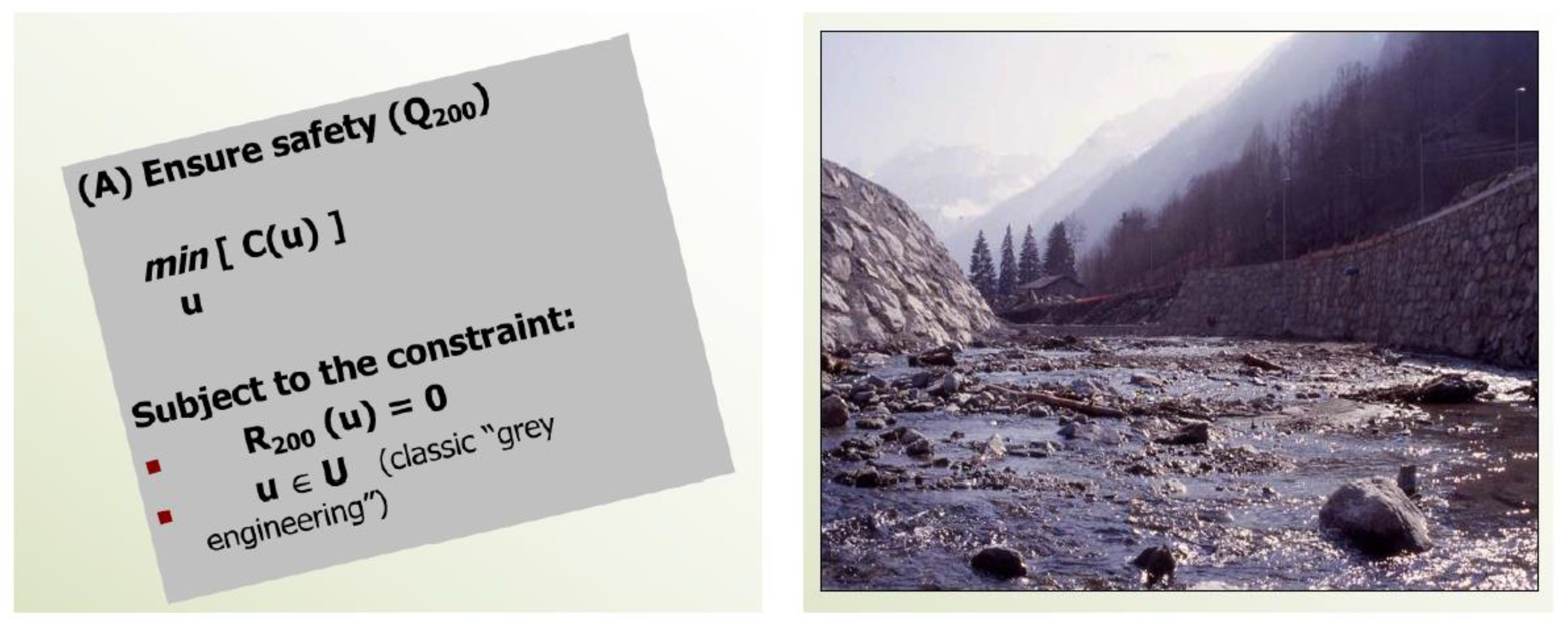

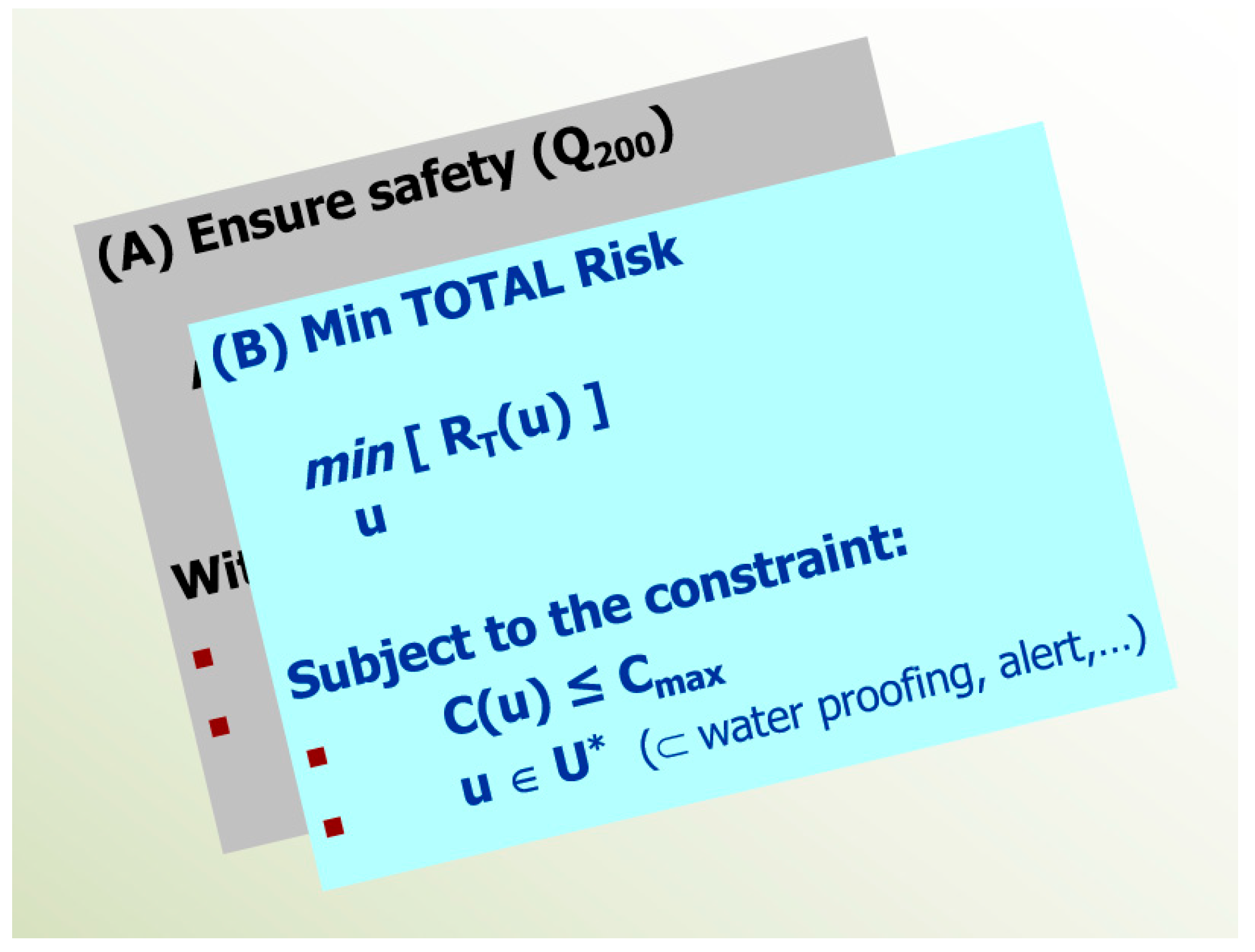
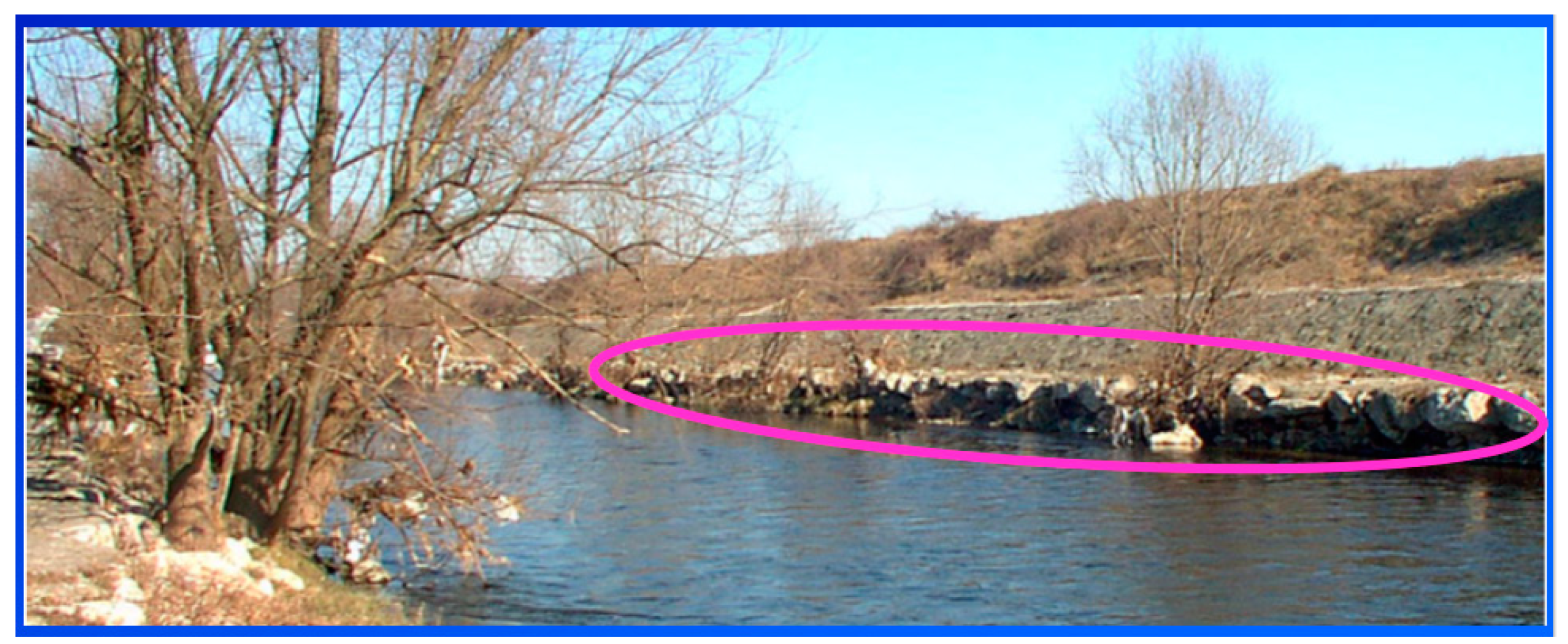
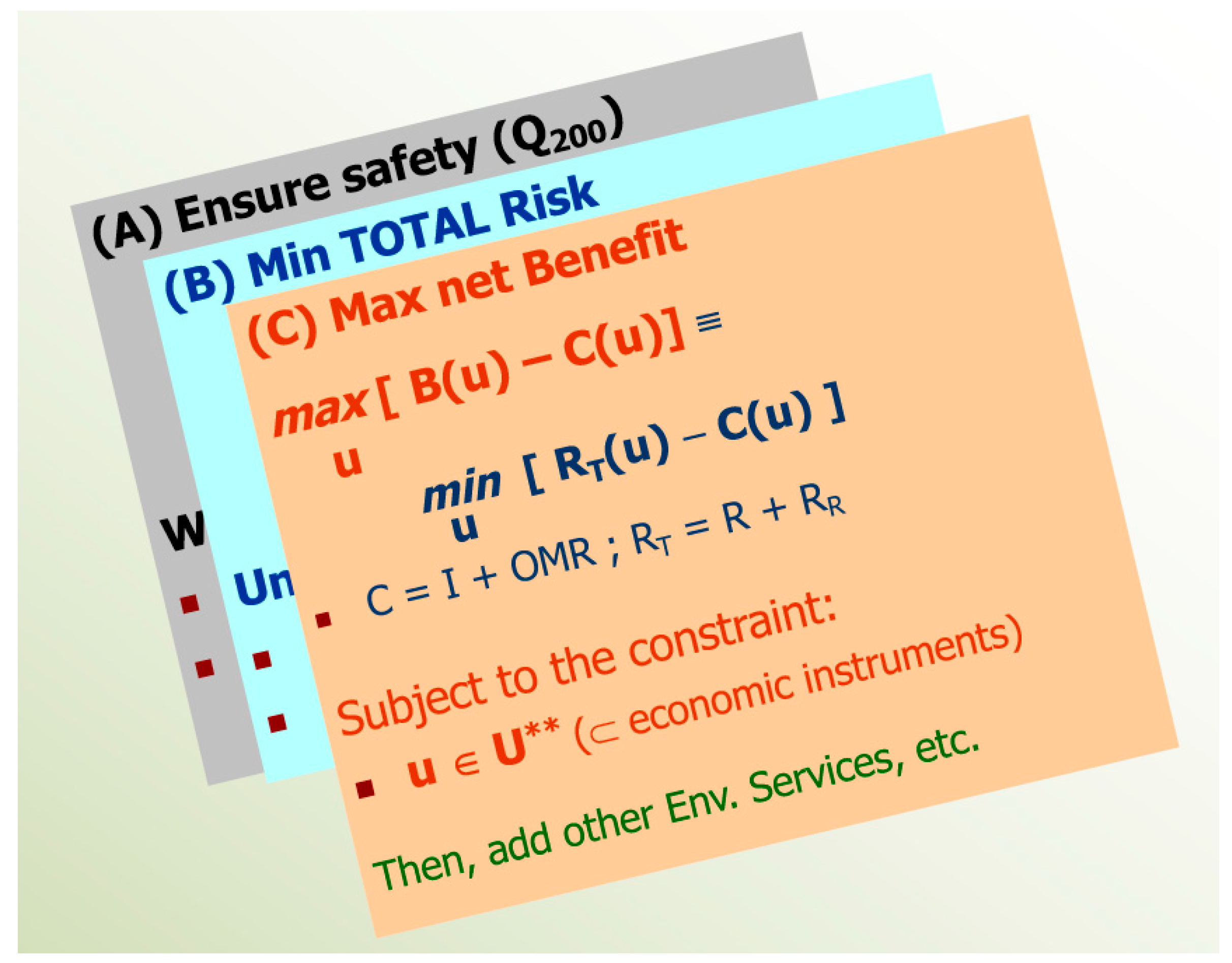
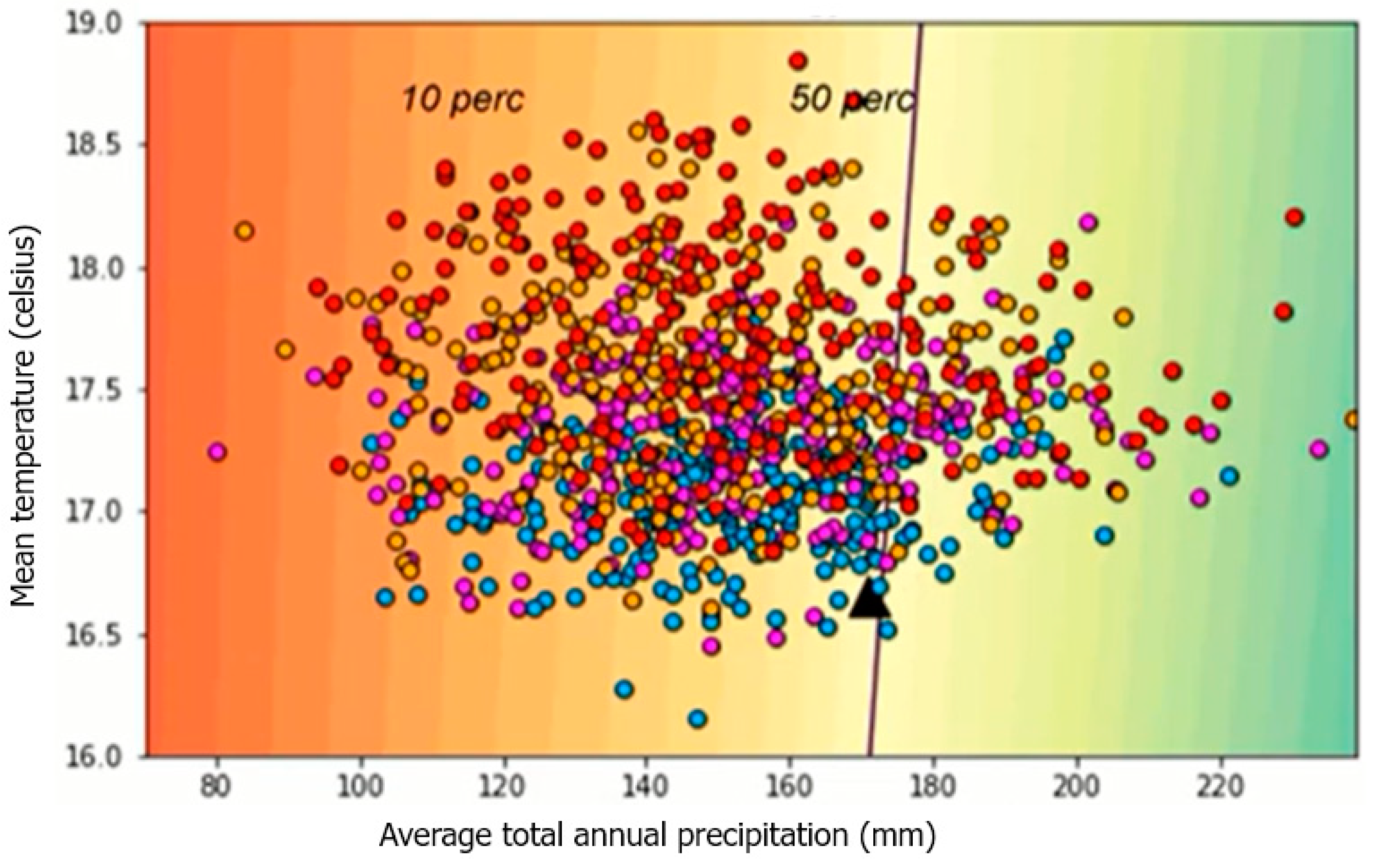

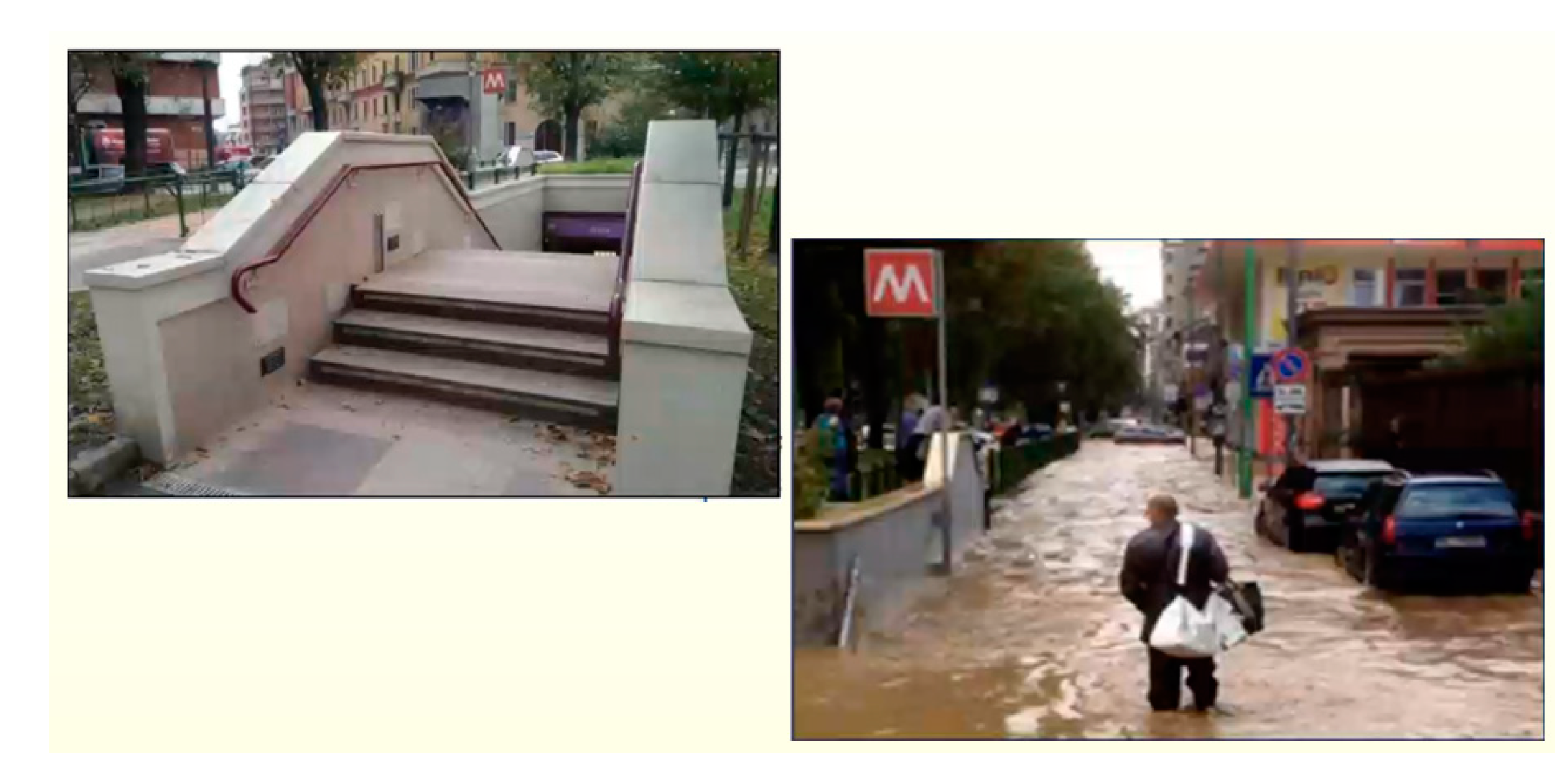
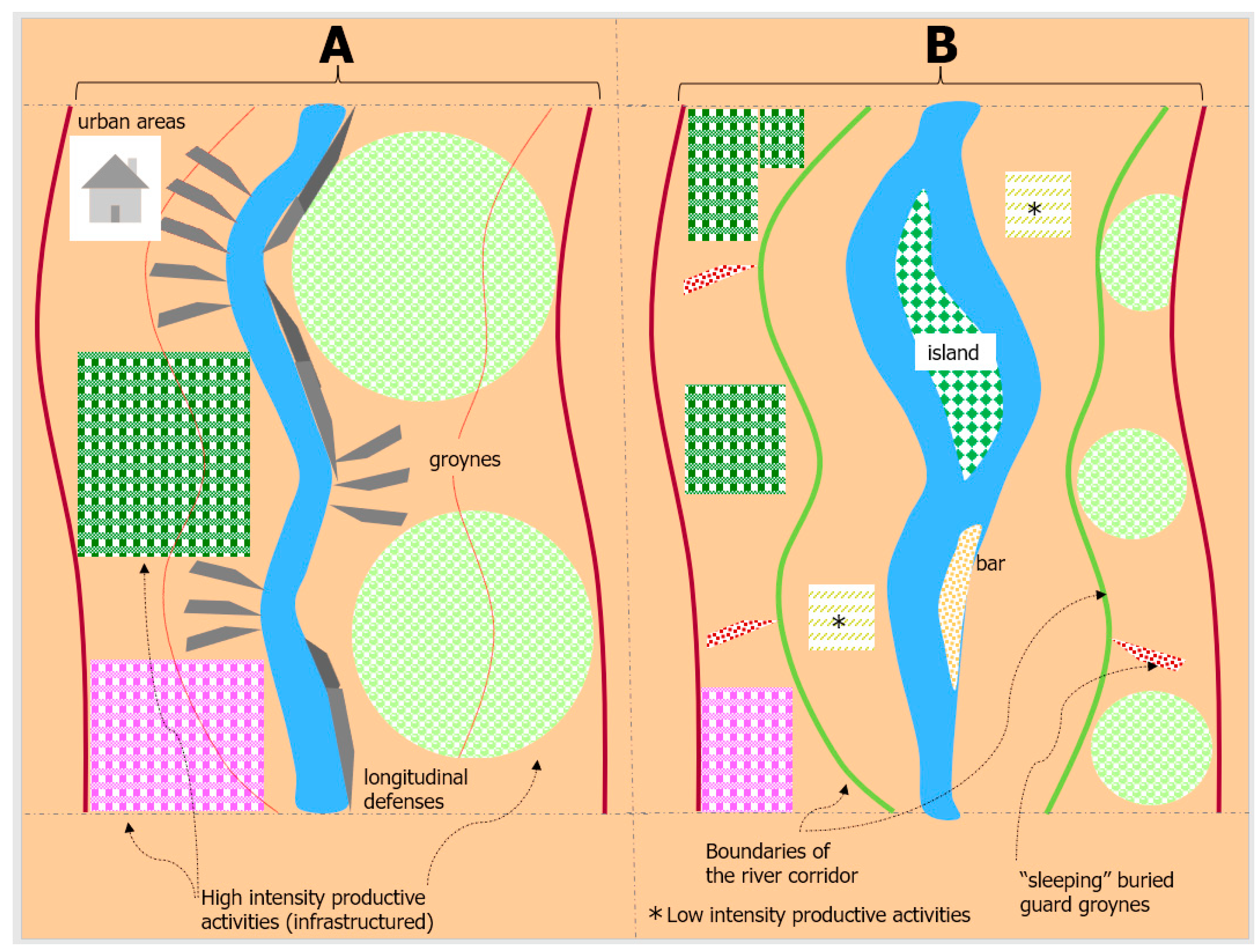
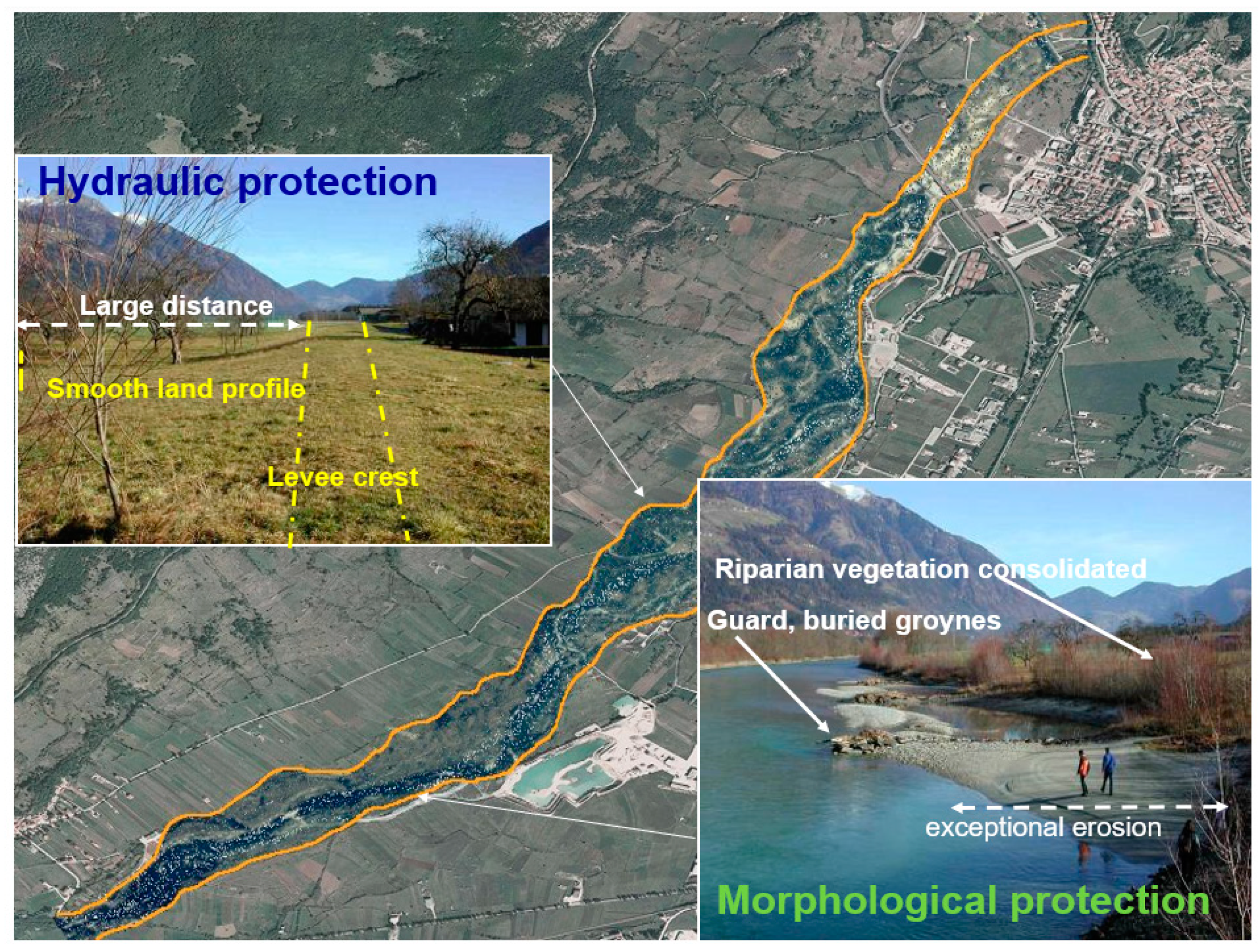
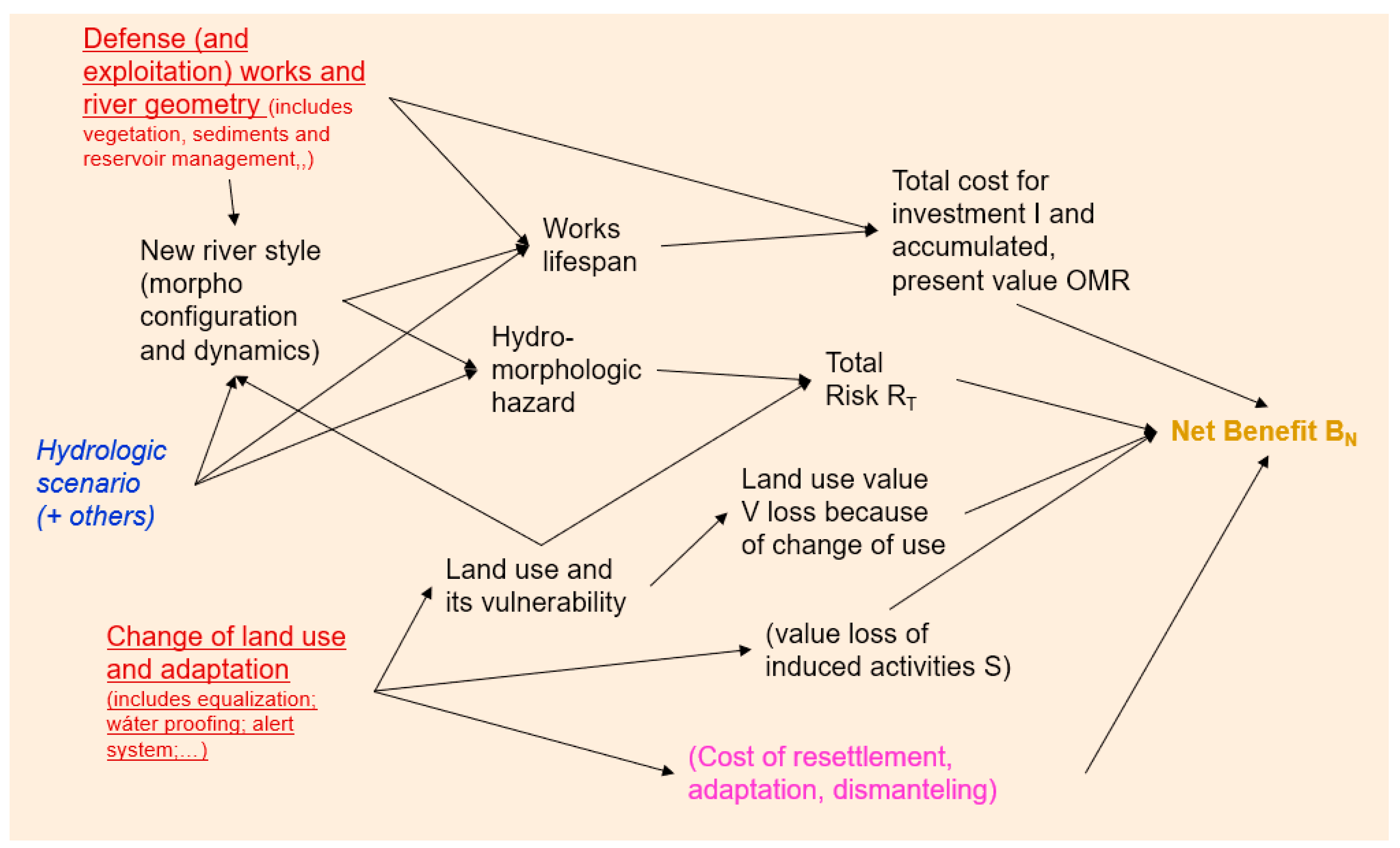
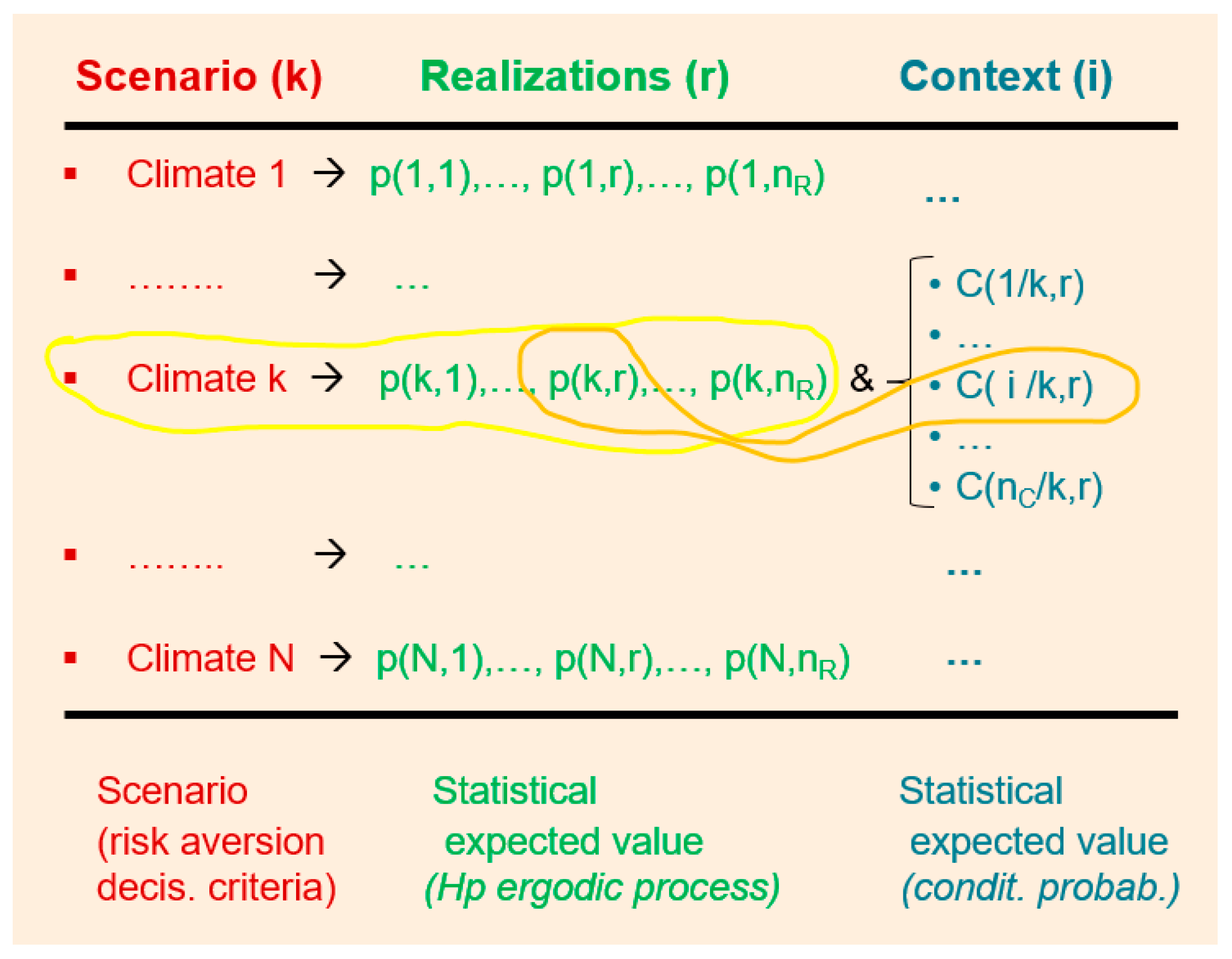
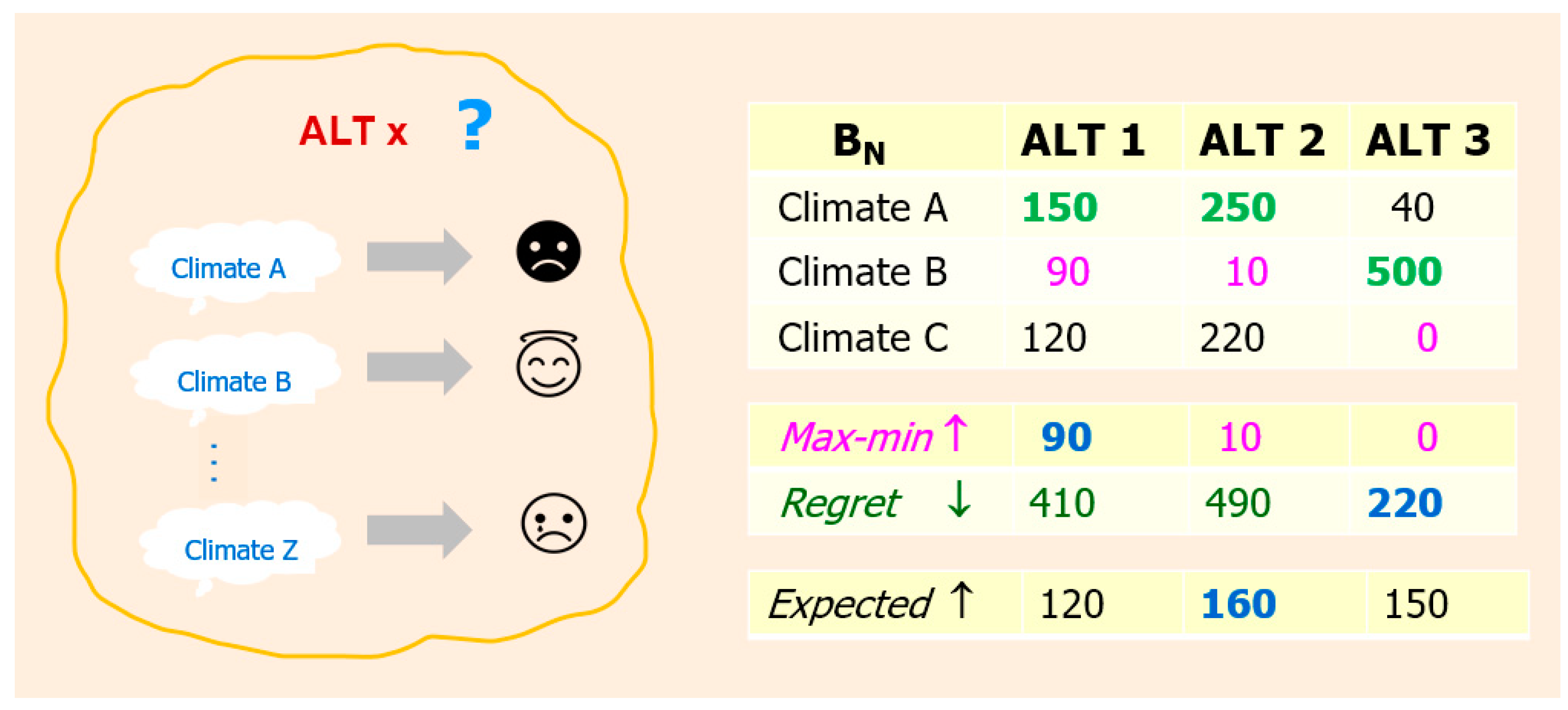
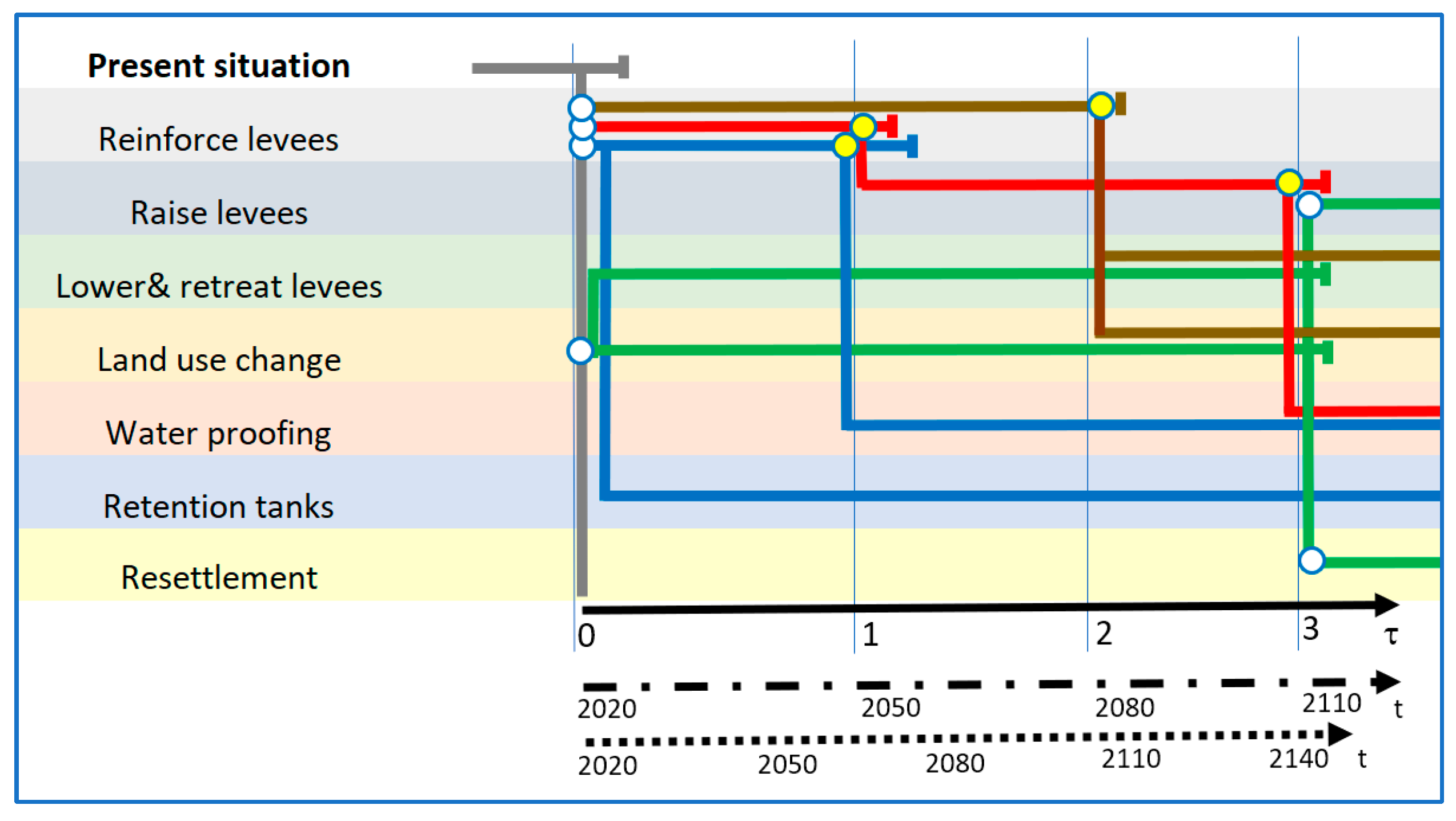
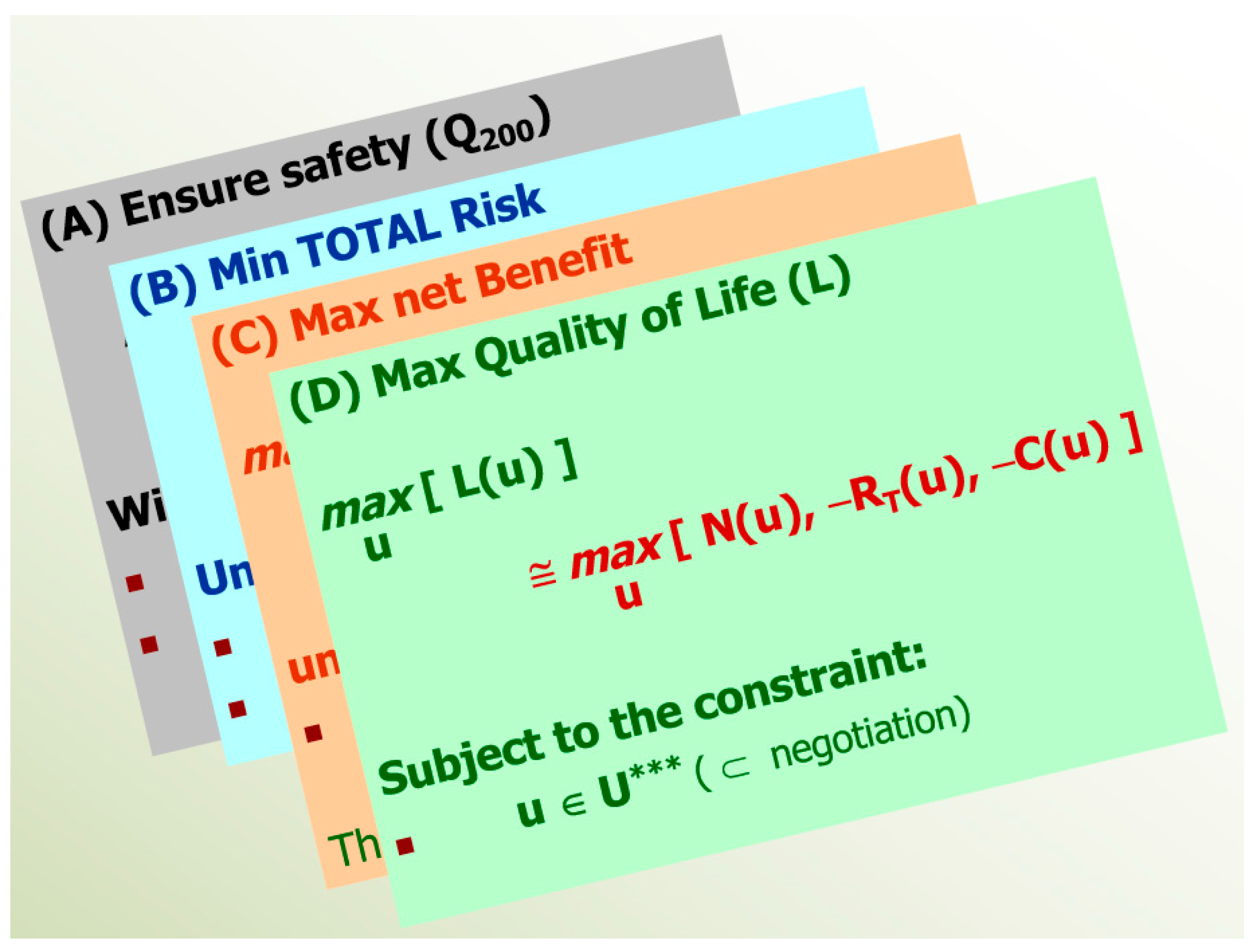
 i [●]. Different spatial units (“pieces”) may be involved: river reaches (k = n), in the case of the ecosystem quality objective N ≡ JN =
i [●]. Different spatial units (“pieces”) may be involved: river reaches (k = n), in the case of the ecosystem quality objective N ≡ JN =  N [JnN]; several land units (land plots r: k = r) of a territory, in the case of the Risk objective R ≡ JR =
N [JnN]; several land units (land plots r: k = r) of a territory, in the case of the Risk objective R ≡ JR =  R [JrR]; some sites (k = s) in the case of the Disturbance objective D ≡ JD =
R [JrR]; some sites (k = s) in the case of the Disturbance objective D ≡ JD =  D [JsD] (e.g., hydropower generation loss in some plants; or loss of agricultural production in given properties). Depending on the formulation of the objective, the involved variables can be extensive (depending on the areas in the case of economic component of risk JrR; or the numerosity of affected hydropower plants), or intensive (e.g., ecosystem quality, in the case of JnN).
D [JsD] (e.g., hydropower generation loss in some plants; or loss of agricultural production in given properties). Depending on the formulation of the objective, the involved variables can be extensive (depending on the areas in the case of economic component of risk JrR; or the numerosity of affected hydropower plants), or intensive (e.g., ecosystem quality, in the case of JnN).
 i [●]. Different spatial units (“pieces”) may be involved: river reaches (k = n), in the case of the ecosystem quality objective N ≡ JN =
i [●]. Different spatial units (“pieces”) may be involved: river reaches (k = n), in the case of the ecosystem quality objective N ≡ JN =  N [JnN]; several land units (land plots r: k = r) of a territory, in the case of the Risk objective R ≡ JR =
N [JnN]; several land units (land plots r: k = r) of a territory, in the case of the Risk objective R ≡ JR =  R [JrR]; some sites (k = s) in the case of the Disturbance objective D ≡ JD =
R [JrR]; some sites (k = s) in the case of the Disturbance objective D ≡ JD =  D [JsD] (e.g., hydropower generation loss in some plants; or loss of agricultural production in given properties). Depending on the formulation of the objective, the involved variables can be extensive (depending on the areas in the case of economic component of risk JrR; or the numerosity of affected hydropower plants), or intensive (e.g., ecosystem quality, in the case of JnN).
D [JsD] (e.g., hydropower generation loss in some plants; or loss of agricultural production in given properties). Depending on the formulation of the objective, the involved variables can be extensive (depending on the areas in the case of economic component of risk JrR; or the numerosity of affected hydropower plants), or intensive (e.g., ecosystem quality, in the case of JnN).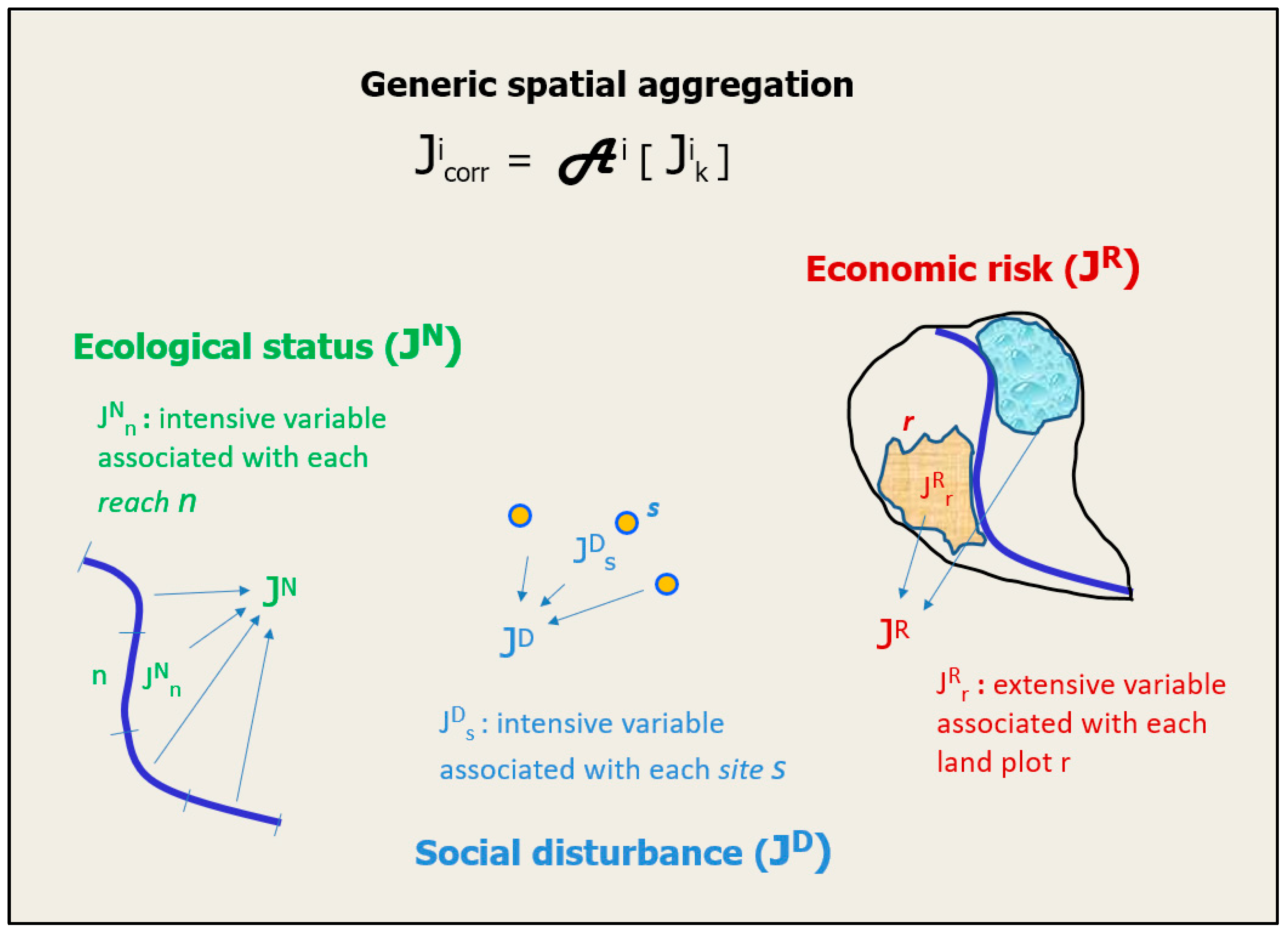
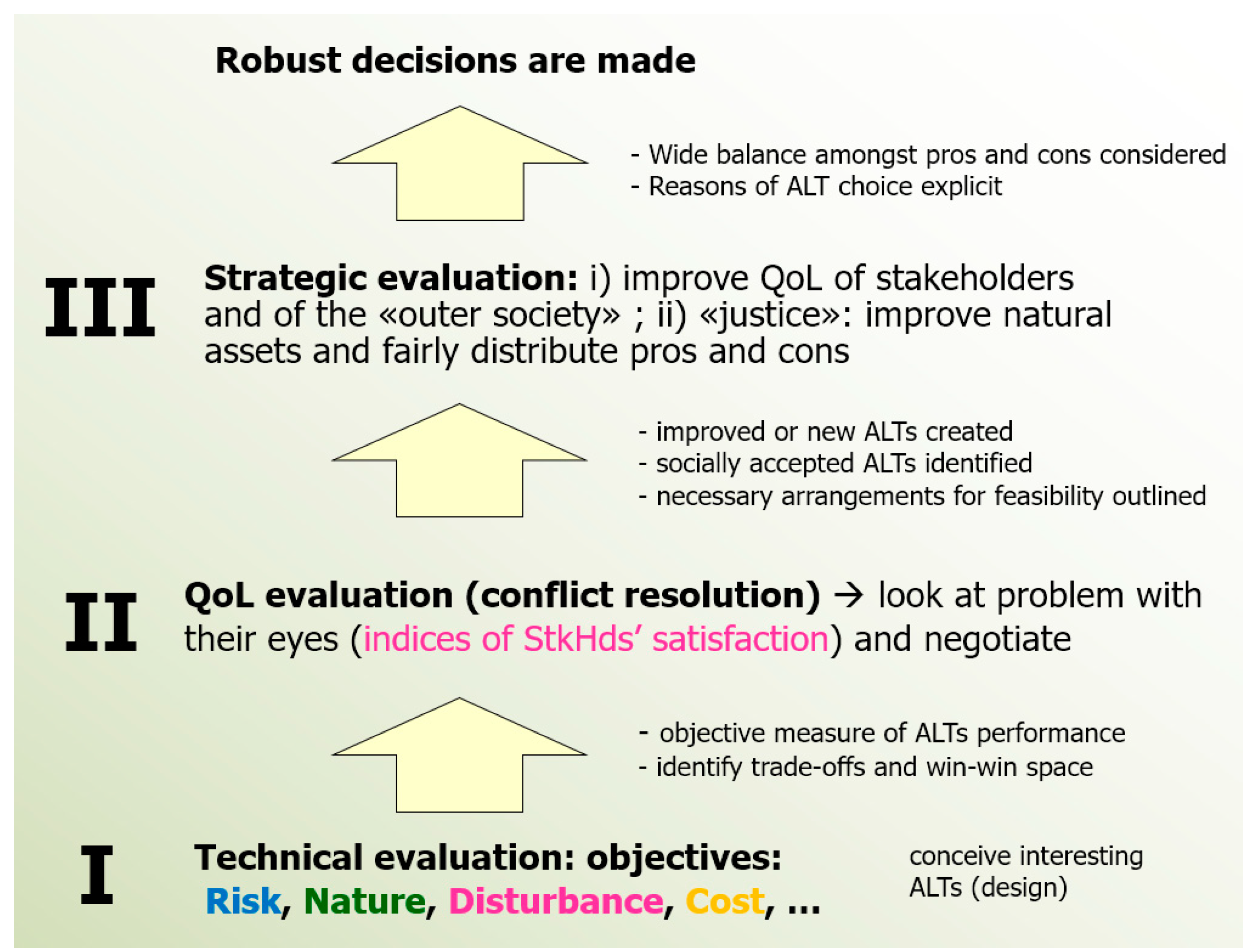
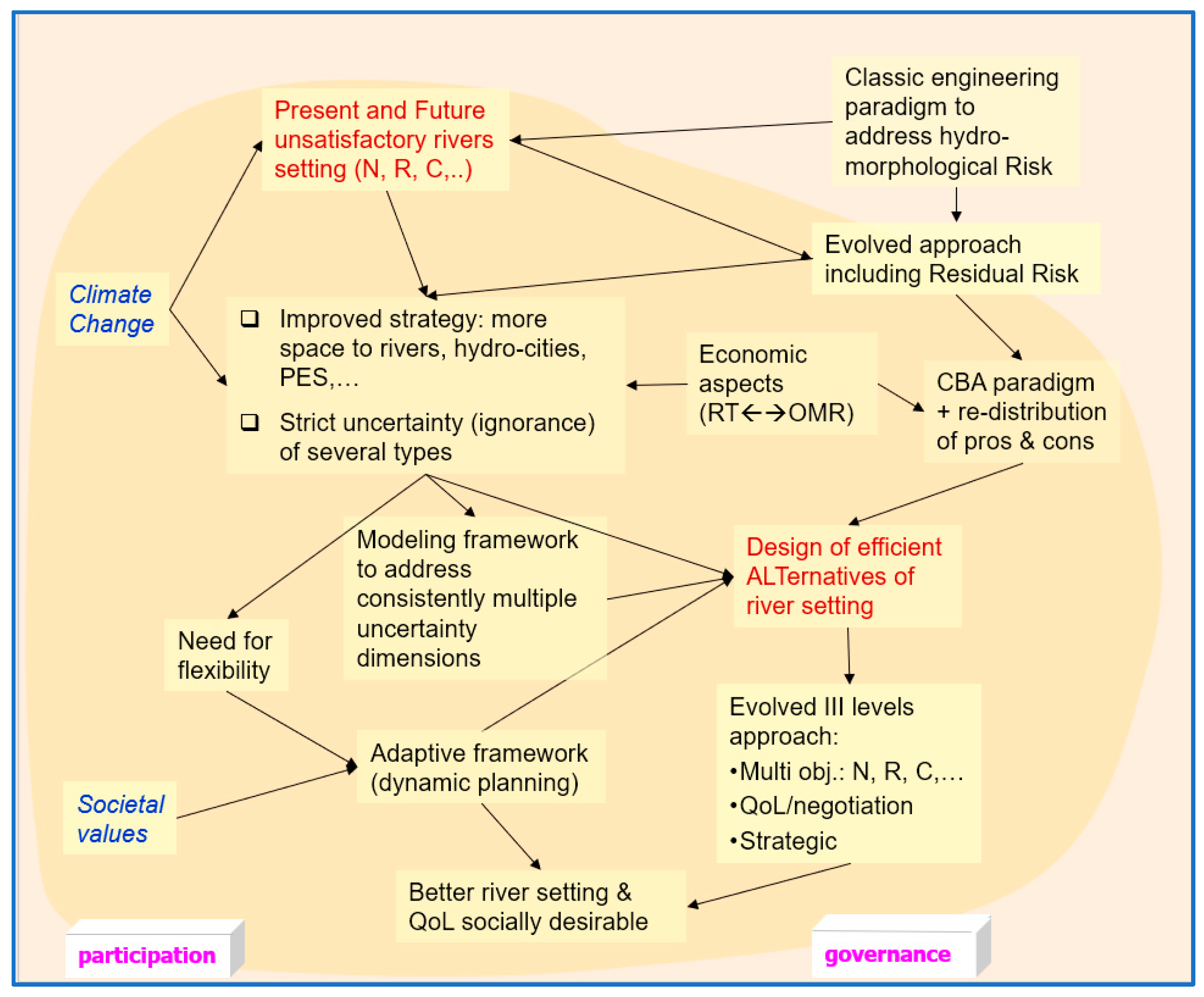
| Year | Italy | Spain | France |
|---|---|---|---|
| 2010 | 194 | 44 | 57 |
| 2020 | 314 | 243 | 198 |
| increase: % | 62 | 452 | 247 |
Publisher’s Note: MDPI stays neutral with regard to jurisdictional claims in published maps and institutional affiliations. |
© 2022 by the author. Licensee MDPI, Basel, Switzerland. This article is an open access article distributed under the terms and conditions of the Creative Commons Attribution (CC BY) license (https://creativecommons.org/licenses/by/4.0/).
Share and Cite
Nardini, A.G.C. Making Room for Our Forthcoming Rivers. Water 2022, 14, 1220. https://doi.org/10.3390/w14081220
Nardini AGC. Making Room for Our Forthcoming Rivers. Water. 2022; 14(8):1220. https://doi.org/10.3390/w14081220
Chicago/Turabian StyleNardini, Andrea Gianni Cristoforo. 2022. "Making Room for Our Forthcoming Rivers" Water 14, no. 8: 1220. https://doi.org/10.3390/w14081220
APA StyleNardini, A. G. C. (2022). Making Room for Our Forthcoming Rivers. Water, 14(8), 1220. https://doi.org/10.3390/w14081220





